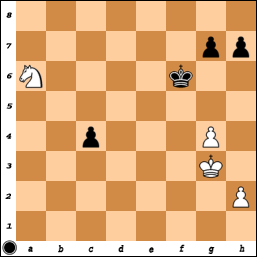Chess Videos
Chess Tools
Other
Book Review: Nunn's Chess Endings, Volume 1 (updated: Volume 2 review!)
The Master of Endgames Comes out Swinging...
John Nunn's newest offering builds on his earlier "Understanding Chess Endgames," to provide a guide to mastering what he calls concrete endgames: practical positions that require precise calculation. While his earlier book covered theoretical ground, Nunn's newest effort focuses on practical situations. This makes Chess Endings both more useful and more difficult. While theoretical examples are intended to illustrate one key endgame idea, whether it be corresponding squares or outside passed pawns, the kind of endings in Nunn's newest book often involve a number of interacting themes and complicated winning strategies. For this reason I wouldn't recommend it for beginning players. If, however, you've mastered basic endgame theory and are willing to put in some hard work, you'll be handsomely rewarded.
Nunn comes out swinging. In the introduction Nunn reveals his incredible analytical precision. He provides a couple of classic endgames alongside what he calls the ending's standard narrative as presented in other, lesser (according to Nunn at least), endgame books. He then reveals that the standard narrative is riddled with errors:

For example, Nunn provides the analysis of Korensky - Suetin, 1973 (above) from Informator 16. He then presents the analysis of the same game from Alburt and Krogius' Winning Chess Endgames-Just the Facts! According to Nunn, "the narrative presented by Albert and Krogius is a simple one: Black exchanges as many pawns as possible on the kingside, and then White can't win because if he plays his king to the queenside then he loses his last pawn." But Nunn won't have any of the standard story: "The trouble is that this narrative isn't even close to the truth. The writers missed virtually all the subtleties of the ending." Yowsa! Nunn then shreds the inherited narrative and provides his own explanation of what turns out to be a fantastically complicated and instructive position.
Once the gauntlet is thrown, Nunn moves on to the "three key endgame skills": calculation, knowledge, and imagination. Judging by my performance on the positions he presents to illustrate each skill, I'm seriously lacking in all three. But no matter, John Nunn is going to put me on the right course.
The rest of the book moves through many difficult and instructive endgames. As Nunn points out in the introduction, "the long-term subtle manueverings which characterize many endgames...are not considered in these books." He's not covering questions of endgame strategy, a la Shereshevsky. Nunn puts an emphasis on precise calculation as the application of endgame knowledge, and it proves persuasive. Along the way he suggests an important reason why studying endgames is a key to chess improvement: you calculate every move and what better way to improve your calculation than by studying a part of the game where a single slip can cost you everything.
The first volume of what appears to be a two volume series, Nunn explains that "volume 1 covers all endings without rooks while Volume 2 deals with all endings with rooks." I wouldn't recommend Volume 1 to beginning players or casual readers, but for those of you looking for real endgame mastery, Nunn's Chess Endings can't be missed.
Volume 2 update: Just spent a few hours going through Nunn's Chess Endings Volume Two, which covers endings with rooks. The analysis is again solid and again, fantastically complicated. I reiterate: this is not for beginners. And just like in volume one, Nunn is eviscerating classic analysis (for example, see Marjanovic-Bronstein, 1979, on page 63). But what I found especially nice was how he's able to take complicated rook endings, connect them to simpler positions that illustrate the constituent ideas of the more complicated position and then return to the original position in a way that helps the reader understand the complex interlocking themes. This is technical, precise, endgame analysis and writing at it's finest.




